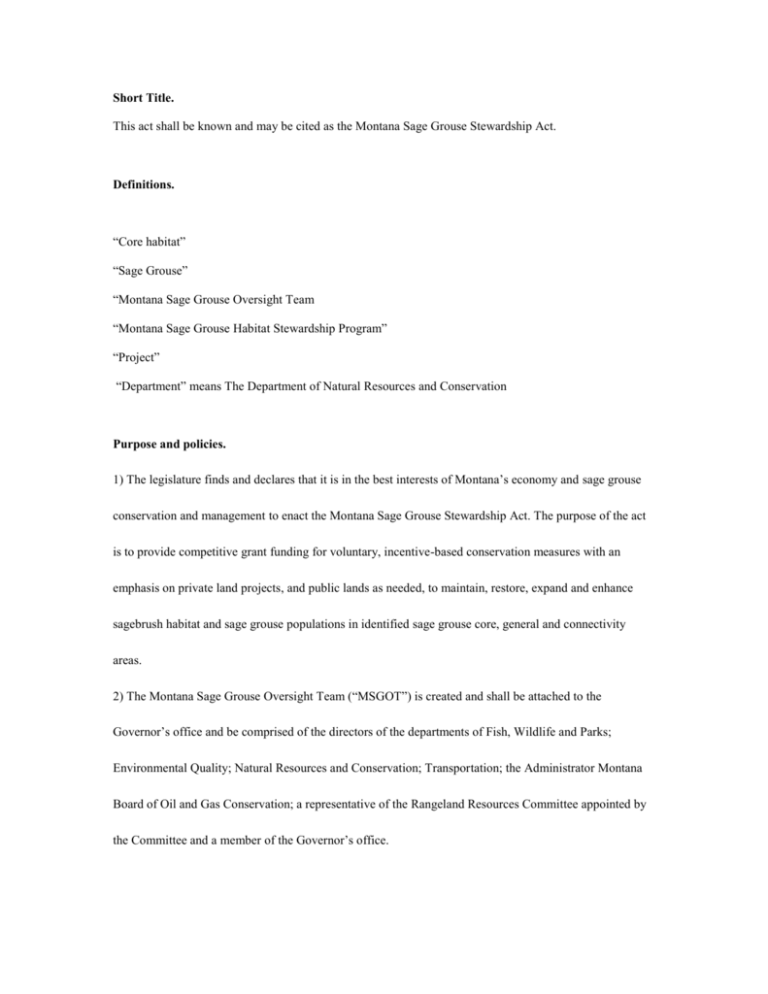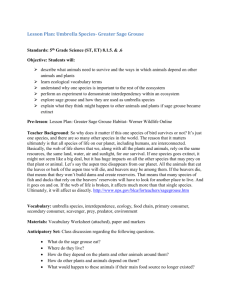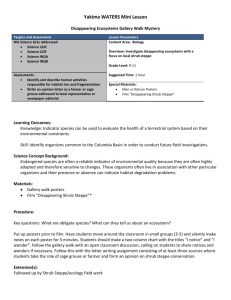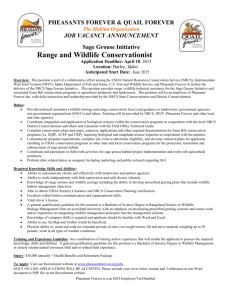Sage Grouse Stewardship Act
advertisement

Short Title. This act shall be known and may be cited as the Montana Sage Grouse Stewardship Act. Definitions. “Core habitat” “Sage Grouse” “Montana Sage Grouse Oversight Team “Montana Sage Grouse Habitat Stewardship Program” “Project” “Department” means The Department of Natural Resources and Conservation Purpose and policies. 1) The legislature finds and declares that it is in the best interests of Montana’s economy and sage grouse conservation and management to enact the Montana Sage Grouse Stewardship Act. The purpose of the act is to provide competitive grant funding for voluntary, incentive-based conservation measures with an emphasis on private land projects, and public lands as needed, to maintain, restore, expand and enhance sagebrush habitat and sage grouse populations in identified sage grouse core, general and connectivity areas. 2) The Montana Sage Grouse Oversight Team (“MSGOT”) is created and shall be attached to the Governor’s office and be comprised of the directors of the departments of Fish, Wildlife and Parks; Environmental Quality; Natural Resources and Conservation; Transportation; the Administrator Montana Board of Oil and Gas Conservation; a representative of the Rangeland Resources Committee appointed by the Committee and a member of the Governor’s office. a) The Montana Sage Grouse Oversight Team shall meet at least once each quarter, in compliance with all Montana open meeting laws and public notification laws and rules. b) The Montana Sage Grouse Oversight Team shall receive and evaluate applications for grants from the Fund, and may approve grant funding for any approved project. The approved projects shall be transmitted to the Department for funding. c) The Montana Sage Grouse Oversight Team shall develop rules governing administration of the act and its purposes that will: i) establish criteria for grants which accomplish the purposes of this act; ii) establish criteria for matching funds or other in-kind contributions from grantees; iii) evaluate, rank and prioritize grant proposals, with an emphasis on those projects that are partnerships involving private and public entities, using the habitat quantification tool described in Section __ below; priority shall be given to projects with matching funds; iv) review and monitor grants to grantees; v) establish criteria on approval of grants that involve multiple land ownerships, including state and public lands, with a requirement that a majority of proposed grant application involves private lands. vi) establish criteria for the acceptance or rejection of gifts, transfers, bequests and donations including interests in real or personal property, which criteria shall not be inconsistent with this act. Based on those criteria, the Montana Sage Grouse Oversight Team shall make recommendations regarding the acceptance of any fee simple interest in real property to the Board of Land Commissioners. Based on those recommendations, the Board of Land Commissioners shall make a final determination on acceptance or rejection of any fee simple interest in real property under this act; ; vii) create a habitat quantification tool that will be used to calculate the sage grouse conservation benefits (i.e., credits) attributable Projects proposed for funding under this Act, as well to calculate the sage grouse impacts (i.e., debits) of development projects that intend, as described in Section __, to mitigate for those impacts through contribution to The Montana Sage Grouse Stewardship Account, established in Section ___; viii) track and maintain as a “bank” the number of conservation credits attributable to Projects funded under this Act, which are available to a project developer for compensatory mitigation, as described in Section ___ below; ix) consider the socioeconomic impacts of the grant proposal in the community; ix) consider other necessary matters affected. 3) There is established in the Department The Montana Sage Grouse Stewardship Account (“the Fund”) to be used to accomplish the purposes of this Act. a) all state appropriated monies shall fund projects to maintain, enhance, restore, and expand sagebrush habitat and sage grouse populations. The program, as provided for in this act, may accept grants, gifts, transfers, bequests and donations including those which are limited in their purposes by the grantor. Title to any interest in any real property conveyed shall be held in the name of the state of Montana and shall be administered by the Board of Land Commissioners. The MSGOT shall develop rules to provide guidance on management options, including lease or sale, of an acquired property consistent with the intent of the act. b) individuals and other entities may also grant, give, transfer, bequest or donate funds to the Fund. Such funds shall be credited to the Fund in a manner consistent with the conditions attached to their receipt. c) the Department is authorized to make grants from the Fund for projects recommended in writing by MSGOT. d) at least 80% of the Fund must be used to secure leases, term conservation easements or permanent conservation easements. 4) In fulfilling its duties under this act the Montana Sage Grouse Management Team: a) Shall solicit and consider in its evaluation of proposed projects the views of interested and affected departments, boards, agencies, commissions, and other subdivisions of the state, including local political subdivisions, of a tribal government, of the federal government, and of other interested and affected persons; b) Accept or decline federal grants and other contributions, grants, gifts, transfers, bequests and donations of any money, personal property or interests in real property other than a fee simple interest from any source. The Montana Sage Grouse Oversight Team shall make recommendations regarding the acceptance of any fee simple interest in real property to the Board of Land Commissioners; c) Participate with for profit corporations to maintain, restore, expand and enhance sage grouse habitat. d) Prior to acquiring an interest in real property, the MSGOT shall publish a notice in a newspaper of local circulation in the county in which the project is located and provide an opportunity for public comment. 5) The legislature authorizes that monies from the Fund may be allocated to projects that maintain, restore, expand and enhance existing sage grouse habitat necessary to maintain sage grouse populations through voluntary, incentive based efforts in sage grouse habitat that include: a) Proposals to reduce conifer encroachment; b) Proposals to reduce spread of invasive weeds detrimental to sagebrush health or sage grouse habitat; c) Proposals to maintain, restore or improve sagebrush health or quality; d) Proposals to purchase or acquire leases or conservation easements that conserve and maintain sagebrush habitat, provide grazing land protection or conserve sage grouse populations; e) Incentives to reduce conversion of grazing land to cropland; f) Proposals to restore cropland to grazing land; g) Proposals to modify fire management to conserve sagebrush habitat or sage grouse populations; h) Proposals to mark fences to reduce sage grouse collisions; i) Proposals to reduce unnatural perching platforms for raptors; j) Proposals to reduce unnatural safe havens for predators; k) Proposals consistent with the act across multiple land management ownerships, including state and federal lands, provided the proposal encompasses a majority of private land and provides benefits to sage grouse across all land ownerships; l) Habitat enhancement that provides project proponents the ability to use improved habitat for project mitigation. m) Other such proposals consistent with the purposes of this act. 6) No funds under this act shall be allocated for, nor is the act authorized to: a) Purchase fee title acquisition of private lands; b) Purchase water rights; c) Require recreational access; d) Allow the release of any species listed under the Endangered Species Act; e) Alter Montana law regarding the primacy of the mineral estate. 7) Leases or conservation easements funded under this act: a) Every lease or conservation easement funded in whole or in part with monies made available by this act shall bind the parties thereto to an agreement which provides that the state of Montana is a third party beneficiary to the lease or easement with the contingent right to enforce the terms of the easement if the grantee fails to enforce any of the terms of the easement. The agreement shall provide that if the lease or easement is transferred for value, sold or extinguished without the consent of the Department, the state of Montana shall have the right to either take legal action to enforce the terms of the lease or easement or to recover from the proceeds of the transfer for value, sale or extinguishment, the state's pro rata share of the proceeds based on the funds the state provided for the creation of the lease or easement. b) No funds shall be disbursed under this act for the purchase of leases or conservation easements which prohibit the use of land for agricultural production if the agricultural activities could be conducted, using current or future technologies and techniques, without infringing on the underlying purpose of the easement. c) No funds shall be disbursed under this act for the purchase of leases or easements which prohibit hunting, fishing or trapping. Mitigation. 1) The legislature finds that it is consistent with the Act’s purpose of incentivizing voluntary conservation measures for sage grouse and its habitat to allow project proponents to compensate for the impacts of proposed development projects on sage grouse by contributing mitigation dollars to the Fund to assist in the funding of conservation Projects. A project developer whose proposed action will have adverse impacts on sage grouse habitat may utilize the habitat quantification tool developed by MSGOT to calculate the debits attributable to its proposed action. The project developer has the option of satisfying its mitigation obligations, in whole or in part, under a mitigation plan approved by MSGOT by obtaining conservation credits from the bank created in Section ___ to offset its debits, as calculated by the habitat quantification tool, through contribution to the Fund. The project developer may also pursue other mitigation options, including, but not limited to, acquiring credits through a habitat exchange or funding standalone mitigation actions. Such mitigation measures shall be consistent with state law and the MSGOT regulations under the Montana Sage Grouse Conservation Program. Grant Applications; eligible entities. (a) The Montana Sage Grouse Oversight Team shall only grant funds to nonprofit and governmental organizations, and shall award grants that maintain, restore, expand or enhance sagebrush habitat and sage grouse populations for the heritage of Montana and its people. The Montana Sage Grouse Oversight Team shall have the discretion to determine the amount of each grant within the provisions established in the act, and shall have the authority to determine any conditions attached to the grant. (b) Grants by the Montana Sage Grouse Oversight Team shall not provide a supplement to, or replacement of, the operating budget of any governmental agency or nonprofit organization except as those funds are directly related to the purposes of the grant. Application to mineral estates. No provision of this act shall be construed to alter Montana law regarding the primacy of the mineral estate, to limit access to the mineral estate or to limit development of the mineral estate. Reporting; transparency. The Montana Sage Grouse Oversight Team and any act staff or administrators shall report to the Environmental Quality Council and the Governor on a regular basis and shall prepare and deliver a detailed written annual report to the Environmental Quality Council, the Governor, the Board of Land Commissioners and county commissions in which projects were funded. The report shall contain information about all federal grants, state appropriations and other contributions, grants, gifts, bequests and donations received and credited to the act. The report shall all include information on each awarded grant and shall provide details about the status and results of each grant awarded. Audits. The Legislative Audit Committee shall audit the act consistent with state law. Copies of the audit shall be provided to the Governor, members of the Legislative Audit Committee, members of the Montana Sage Grouse Oversight Team, the Environmental Quality Council and others as needed. This Act is effective on passage and approval.






